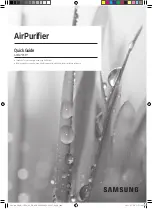
Manual 2100-426
Page 6
WALL MOUNTING INFORMATION
1. Two holes, for the supply and return air openings,
must be cut through the wall as shown in Figure 3.
2. On wood-frame walls, the wall construction must be
strong and rigid enough to carry the weight of the
unit without transmitting any unit vibration. See
Figures 5 and 6.
INSTALLATION INSTRUCTIONS
WARNING
Fire hazard can result if 1/4 inch clearance to
combustible materials for supply air duct is not
maintained. See Figure 3.
3. Concrete block walls must be thoroughly inspected to
insure that they are capable of carrying the weight of
the installing unit. See Figure 5.
MOUNTING THE UNIT
1. These units are secured by wall mounting brackets
which secure the unit to the outside wall surface at
both sides. A bottom mounting bracket is provided
for ease of installation.
2. The unit itself is suitable for “0” inch clearance, but
the supply air duct flange and the first 3 feet of
supply air duct require a minimum of 1/4 inch
clearance to combustible material. If a combustible
wall, use a minimum of 30-1/2" x 10-1/2"
dimensions for sizing. However, it is generally
recommended that a 1 inch clearance is used for ease
of installation and maintaining the required clearance
to combustible material. The supply air opening
would then be 32" x 12". See Figures 3, 4 and 5 for
details.
3. Locate and mark lag bolt locations and bottom
mounting bracket location. See Figure 5.
4. Mount bottom mounting bracket.
5. Hook top rain flashing under back bend of top. Top
rain flashing is shipped secured to the right side of
the back.
6. Position unit in opening and secure with 5/16 lag
bolts; use 7/8 inch diameter flat washers on the lag
bolts.
7. Secure rain flashing to wall and caulk across entire
length of top. See Figure 3.
8. For additional mounting rigidity, the return air and
supply air frames or collars can be drilled and
screwed or welded to the structural wall itself
(depending upon wall construction). Be sure to
observe required clearance if combustible wall.
9. On side by side installations, maintain a minimum of
20 inches clearance on left side to allow access to
heat strips and control panel and to allow proper
airflow to the outdoor coil. Additional clearance may
be required to meet local or national codes.
TYPICAL INSTALLATIONS
See Figure 6 for common ways to install the wall-mount
unit.
WIRING — MAIN POWER
Refer to the unit rating plate for wire sizing information
and maximum fuse or “HACR" type circuit breaker
size. Each outdoor unit is marked with a “Minimum
Circuit Ampacity”. This means that the field wiring
used must be sized to carry that amount of current.
Depending on the installed KW of electric heat, there
may be two field power circuits required. If this is the
case, the unit serial plate will so indicate. All models are
suitable only for connection with copper wire. Each unit
and/or wiring diagram will be marked “Use Copper
Conductors Only”. These instructions must be adhered
to. Refer to the National Electrical Code (NEC) for
complete current carrying capacity data on the various
insulation grades of wiring material. All wiring must
conform to NEC and all local codes.
The electrical data lists fuse and wire sizes (75ºC
copper) for all models, including the most commonly
used heater sizes. Also shown are the number of field
power circuits required for the various models with
heaters.
The unit rating plate lists a “Maximum Time Delay
Relay Fuse” or “HACR" type circuit breaker that is to
be used with the equipment. The correct size must be
used for proper circuit protection and also to assure that
there will be no nuisance tripping due to the momentary
high starting current of the compressor motor.
WARNING
Failure to provide the 1/4 inch clearance
between the supply duct and a combustible
surface for the first 3 feet of duct can result in
fire.
Summary of Contents for WL701-B
Page 12: ...Manual 2100 426 Page 10 FIGURE 7 COMMONWALL MOUNTINGINSTALLATIONS MIS 1050...
Page 13: ...Manual 2100 426 Page 11 FIGURE 8 LOWVOLTAGEWIRING MIS 1373C...
Page 19: ......
Page 20: ......
Page 21: ......







































